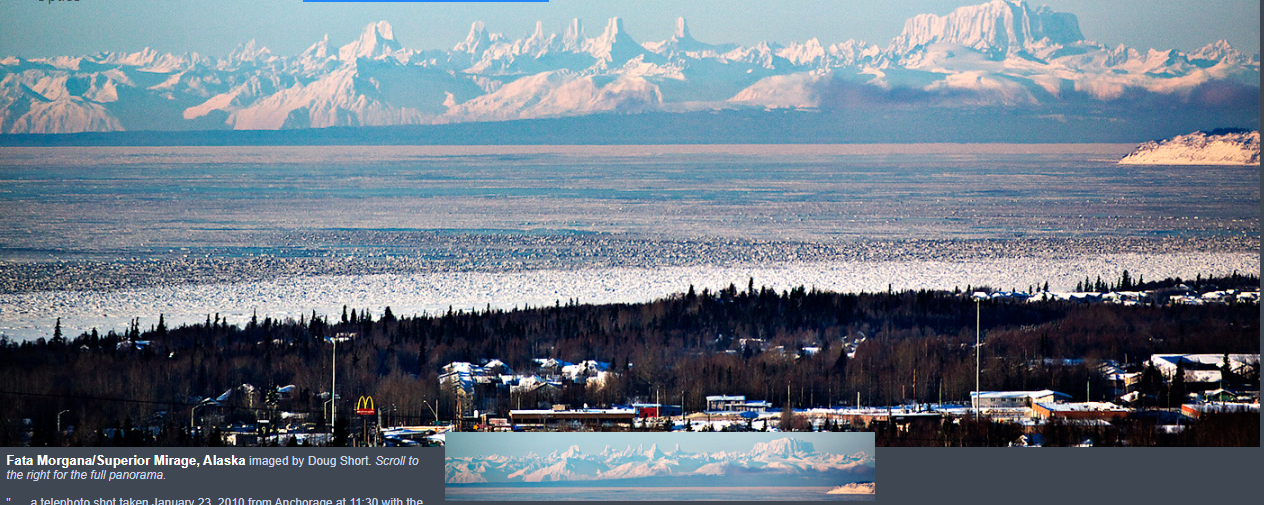Fata Morgana, Alaska
Fata Morgana, Alaska: A Spectacular Mirage Phenomenon
In the enchanting landscapes of Alaska, a mesmerizing optical phenomenon known as Fata Morgana occasionally graces the skies. Fata Morgana is a type of mirage that occurs when abnormally cold air gets trapped beneath warmer air, creating a temperature inversion. This atmospheric condition can lead to the bending of light rays, resulting in the appearance of distorted and surreal images in the sky.
When temperature gradients are particularly strong, light rays slanting upwards across the cold-to-warm air boundary become refracted and are then bent back down again. This phenomenon causes distant objects near the ground to appear as if they are floating in the sky. This type of mirage is commonly referred to as a "superior" mirage and is a regular occurrence in various regions around the world.
However, in certain temperature profiles within the inversion layer, the Fata Morgana mirage takes on a more dramatic form. Instead of simple floating objects, this mirage manifests as towering columns resembling architectural structures. These ethereal structures, often referred to as "castles in the air," create an awe-inspiring spectacle for those lucky enough to witness them. In Alaska, the Fata Morgana mirage sometimes exhibits features reminiscent of the legendary Fata Morgana phenomenon.
To capture the enchanting beauty of this Alaskan mirage, photographer Doug Short embarked on a journey on January 23, 2010. Armed with a telephoto lens and situated approximately 600 feet above sea level in Anchorage, he aimed to document this mesmerizing event. With the sun positioned at about 7° above the horizon, Short captured a panoramic shot showcasing the northern part of the Aleutian Range, which lies approximately 90 miles away from Anchorage. The photo also encompasses the ice-choked northern portion of Cook Inlet, adding to the breathtaking vista.
Despite the hazy conditions of the day, the tops of the mountains in the image appeared significantly distorted. This distortion is a telltale sign of the Fata Morgana mirage, which can manipulate and transform the appearance of distant objects. The mirage's influence on the landscape creates an otherworldly experience, where reality and illusion seem to intertwine.
The Fata Morgana mirage is a natural phenomenon that has fascinated scientists and observers for centuries. While its occurrence is relatively rare, Alaska's unique combination of geographical features and atmospheric conditions makes it an ideal location for witnessing this captivating spectacle. The mirage's presence adds an extra layer of wonder to the already breathtaking scenery of the state, captivating both locals and visitors alike.
In conclusion, Fata Morgana, Alaska showcases the magic of atmospheric optics at its finest. This mirage phenomenon, born from temperature inversions, bends light rays to create surreal and distorted images in the sky. With its towering architectural features and dreamlike landscapes, the Fata Morgana mirage in Alaska is a sight to behold. For those fortunate enough to witness it, it offers a glimpse into the wondrous and ever-changing nature of our atmosphere.

Fata Morgana/Superior Mirage, Alaska imaged by Doug Short. Scroll to the right for the full panorama.
" ...a telephoto shot taken January 23, 2010 from Anchorage at 11:30 with the sun at about 7° above the horizon. The background mountains are the northern part of the Aleutian Range and average 90 miles or so from Anchorage. The photo looks across the ice choked northern portion of Cook Inlet. The day was a bit hazy but the tops of the mountains were quite distorted so I took a shot from around 600 ft. above sea level."
�Doug Short, shown with permission.
AtmosphericOptics
About - Submit Optics Picture of the Day Galleries Previous Next Today Subscribe to Features on RSS Feed
These mirages are produced by abnormally cold air air trapped beneath warmer - a temperature inversion.
Light rays slanting upwards across the cold-to-warm air boundary are refracted back down again if the temperature gradients are strong. The result is that distant features near to the ground appear in the sky. This is the behaviour of an ordinary 'superior' mirage.
Particular temperature profiles in the inversion can instead produce the towering column-like architectural features, 'castles in the air', characteristic of the fabled Fata Morgan mirage. This Alaskan mirage has some Fata Morgana features.

More mirages
Note: this article has been automatically converted from the old site and may not appear as intended. You can find the original article here.
Reference Atmospheric Optics
If you use any of the definitions, information, or data presented on Atmospheric Optics, please copy the link or reference below to properly credit us as the reference source. Thank you!
-
<a href="https://atoptics.co.uk/blog/fata-morgana-alaska/">Fata Morgana, Alaska</a>
-
"Fata Morgana, Alaska". Atmospheric Optics. Accessed on November 26, 2024. https://atoptics.co.uk/blog/fata-morgana-alaska/.
-
"Fata Morgana, Alaska". Atmospheric Optics, https://atoptics.co.uk/blog/fata-morgana-alaska/. Accessed 26 November, 2024
-
Fata Morgana, Alaska. Atmospheric Optics. Retrieved from https://atoptics.co.uk/blog/fata-morgana-alaska/.